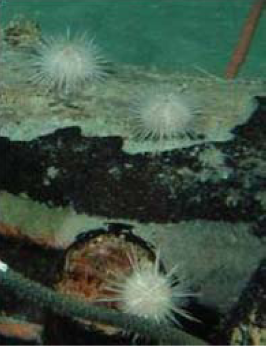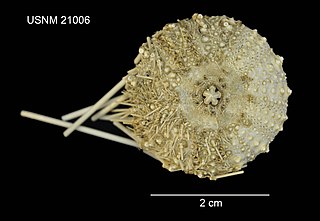
The Aspidodiadematidae are a family of sea urchins.

The Echinothurioida are an order of sea urchins in the class Echinoidea. Echinothurioids are distinguished from other sea urchins by the combination of a flexible test and hollow spines. The membrane around the mouth contains only simple plates, in contrast to the more complex mouth parts of their close relatives, the Diadematoida. They are nearly all deepsea dwellers.

The Camarodonta are an order of globular sea urchins in the class Echinoidea. The fossil record shows that camarodonts have been in existence since the Lower Cretaceous.
Aspidodiadema annulatum is a species of sea urchin of the family Aspidodiadematidae. Their armour is covered with spines. It is placed in the genus Aspidodiadema and lives in the sea. Aspidodiadema annulatum was first scientifically described in 1927 by Koehler.

Aspidodiadema arcitum is a species of sea urchin of the family Aspidodiadematidae. Their armour is covered with spines. It is placed in the genus Aspidodiadema and lives in the sea. Aspidodiadema arcitum was first scientifically described in 1939 by Ole Theodor Jensen Mortensen, a Danish scientist.

Aspidodiadema hawaiiense is a species of sea urchin of the family Aspidodiadematidae. Their armor is covered with spines. It is placed in the genus Aspidodiadema and lives in the sea. Aspidodiadema hawaiiense was first scientifically described in 1939 by Ole Theodor Jensen Mortensen, a Danish scientist.
Aspidodiadema intermedium is a species of sea urchin of the family Aspidodiadematidae. Their armour is covered with spines. It is placed in the genus Aspidodiadema and lives in the sea. Aspidodiadema intermedium was first scientifically described in 1977 by Shigei.
Aspidodiadema nicobaricum is a species of sea urchin of the family Aspidodiadematidae. Their armour is covered with spines. It is placed in the genus Aspidodiadema and lives in the sea. Aspidodiadema nicobaricum was first scientifically described in 1901 by Döderlein.
Aspidodiadema sinuosum is a species of sea urchin of the family Aspidodiadematidae. Their armour is covered with spines. It is placed in the genus Aspidodiadema and lives in the sea. Aspidodiadema sinuosum was first scientifically described in 1981 by Mironov.
Aspidodiadema tonsum is a species of sea urchin of the family Aspidodiadematidae. Their armour is covered with spines. It is placed in the genus Aspidodiadema and lives in the sea. Aspidodiadema tonsum was first scientifically described in 1879 by Alexander Emanuel Agassiz.

Asterechinus elegans is a species of sea urchin of the family Trigonocidaridae. Their armour is covered with spines. It is the only species in the genus Asterechinus and lives in the sea. Asterechinus elegans was first scientifically described in 1942 by Ole Theodor Jensen Mortensen.
Breynia elegans is a species of sea urchins of the family Loveniidae. Their armour is covered with spines. Breynia elegans was first scientifically described in 1948 by Ole Theodor Jensen Mortensen.

Caenopedina diomedeae is a species of sea urchins of the Family Pedinidae. Their armour is covered with spines. Caenopedina diomedeae was first scientifically described in 1939 by Ole Theodor Jensen Mortensen.
Chaetodiadema africanum is a species of sea urchins of the Family Diadematidae. Their armour is covered with spines. Chaetodiadema africanum was first scientifically described in 1924 by Hubert Lyman Clark.

Chaetodiadema granulatum is a species of sea urchins of the Family Diadematidae. Their armour is covered with long and slender spines, and the test is quite flattened.
Chaetodiadema japonicum is a species of sea urchins of the Family Diadematidae. Their armor is covered with spines. Chaetodiadema japonicum was first scientifically described in 1904 by Ole Theodor Jensen Mortensen.
Chaetodiadema keiense is a species of sea urchins of the family, Diadematidae. Their armour is covered with spines. Chaetodiadema keiense was first scientifically described in 1939 by Ole Theodor Jensen Mortensen.
Cidaris mabahissae is a species of sea urchins of the Family Cidaridae. Their armour is covered with spines. Cidaris mabahissae was first scientifically described in 1939 by Ole Mortensen.

Chaetodiadema is a genus of sea urchins of the Family Diadematidae. Their armour is covered with spines.

Aspidodiadema is a genus of echinoderms belonging to the family Aspidodiadematidae. The species of this genus are found in the Indo-Pacific and Caribbean.









